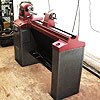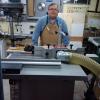Last week I burned up my router motor making raised panels. I'm pretty sure of why it happened, but I want to run it by you guys to make sure I don't ever do this again, $150 is a steep price for a mistake.
Details: Making raised panels in western maple with a dewalt 618 2&1/4HP router (in a table), freud 1/2" 2+2 3&1/4" bit with backcutter (brand new bit), router on setting "1".
Everything I had read here made me think I needed to accomplish the cut in multiple passes, but when I watched the instructional video that came with the raised panel bit set the demonstrator did it in one pass (albeit using a 3+ HP router). So, I went against my better judgement and started doing them in one pass. Panels are roughly 15"X32", the first one went well so I stopped being worried about it, I started getting warning signs and a light smell on the second panel but ignored it like an idiot, router burned up on the third panel. Severe smoke, still hot to the touch 30 min after I removed it from the table. I'm running a 6" dust port around the router at the base of the table and through that would keep it pretty cool but I was misguided in that idea. I think I should have just done it in multiple passes and maybe gave the router some cool down time between panels, would this probably have done the trick?
Questions?
- Was I incorrect to try to do this much in one pass with my router?
- Are there shapers that take 1/2" router bits that I can buy to be able to do this kind of thing in one pass?
- Was the video showing an improper technique or would this thing be okay if I had been using the same 3HP+ router as the video?
Thanks in advance for the input,
Andy




 Reply With Quote
Reply With Quote








